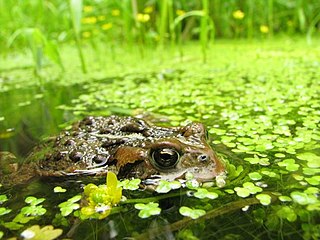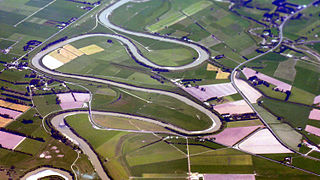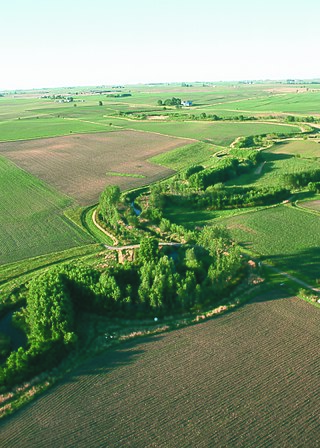
Ecology is the natural science of the relationships among living organisms, including humans, and their physical environment. Ecology considers organisms at the individual, population, community, ecosystem, and biosphere levels. Ecology overlaps with the closely related sciences of biogeography, evolutionary biology, genetics, ethology, and natural history.

A wetland is a distinct semi-aquatic ecosystem whose groundcovers are flooded or saturated in water, either permanently, for years or decades, or only seasonally. Flooding results in oxygen-poor (anoxic) processes taking place, especially in the soils. Wetlands form a transitional zone between waterbodies and dry lands, and are different from other terrestrial or aquatic ecosystems due to their vegetation's roots having adapted to oxygen-poor waterlogged soils. They are considered among the most biologically diverse of all ecosystems, serving as habitats to a wide range of aquatic and semi-aquatic plants and animals, with often improved water quality due to plant removal of excess nutrients such as nitrates and phosphorus.

An ecosystem engineer is any species that creates, significantly modifies, maintains or destroys a habitat. These organisms can have a large impact on species richness and landscape-level heterogeneity of an area. As a result, ecosystem engineers are important for maintaining the health and stability of the environment they are living in. Since all organisms impact the environment they live in one way or another, it has been proposed that the term "ecosystem engineers" be used only for keystone species whose behavior very strongly affects other organisms.

Ecological engineering uses ecology and engineering to predict, design, construct or restore, and manage ecosystems that integrate "human society with its natural environment for the benefit of both".

Ecological restoration, or ecosystem restoration, is the process of assisting the recovery of an ecosystem that has been degraded, damaged, destroyed or transformed. It is distinct from conservation in that it attempts to retroactively repair already damaged ecosystems rather than take preventative measures. Ecological restoration can reverse biodiversity loss, combat climate change, support the provision of ecosystem services and support local economies. The United Nations has named 2021-2030 the Decade on Ecosystem Restoration.

Hydrobiology is the science of life and life processes in water. Much of modern hydrobiology can be viewed as a sub-discipline of ecology but the sphere of hydrobiology includes taxonomy, economic and industrial biology, morphology, and physiology. The one distinguishing aspect is that all fields relate to aquatic organisms. Most work is related to limnology and can be divided into lotic system ecology and lentic system ecology.
The Wilma H. Schiermeier Olentangy River Wetland Research Park is an experimental wetland complex located adjacent to the campus of Ohio State University in Columbus, Ohio, United States and is part of the School of Environment and Natural Resources at the university. Begun in 1992, the park has developed into a multitude of different habitats and setups which are used by OSU faculty and students for research. Additionally, the general public is welcome to enjoy independent tours of the area during daylight hours. Guided tours are also available upon request.

Floodplain restoration is the process of fully or partially restoring a river's floodplain to its original conditions before having been affected by the construction of levees (dikes) and the draining of wetlands and marshes.

Wetland conservation is aimed at protecting and preserving areas of land including marshes, swamps, bogs, and fens that are covered by water seasonally or permanently due to a variety of threats from both natural and anthropogenic hazards. Some examples of these hazards include habitat loss, pollution, and invasive species. Wetland vary widely in their salinity levels, climate zones, and surrounding geography and play a crucial role in maintaining biodiversity, ecosystem services, and support human communities. Wetlands cover at least six percent of the Earth and have become a focal issue for conservation due to the ecosystem services they provide. More than three billion people, around half the world's population, obtain their basic water needs from inland freshwater wetlands. They provide essential habitats for fish and various wildlife species, playing a vital role in purifying polluted waters and mitigating the damaging effects of floods and storms. Furthermore, they offer a diverse range of recreational activities, including fishing, hunting, photography, and wildlife observation.

A freshwater marsh is a non-forested marsh wetland that contains shallow fresh water, and is continuously or frequently flooded. Freshwater marshes primarily consist of sedges, grasses, and emergent plants. Freshwater marshes are usually found near the mouths of rivers, along lakes, or are present in low lying areas with low drainage like abandoned oxbow lakes. Unlike its counterpart the salt marsh, which is regularly flushed with sea water, freshwater marshes receive the majority of their water from surface water.
A seed bank stores seeds from plants and is significant in preserving plant genetic diversity. Seed banks can be categorized according to their location and the ecological functions they serve. The primary types include soil seed banks, which are found in terrestrial environments; wetland seed banks, located in aquatic habitats; and canopy seed banks, present in the upper layers of forest ecosystems. Each type of seed contributes uniquely to plant biodiversity, ecosystem resilience and human well-being. Also, they are unique in the way they retain their seed. For example, in canopy seed banks or aerial seed banks, the seeds are stored in the canopies of trees and plants.

Mangrove ecosystems represent natural capital capable of producing a wide range of goods and services for coastal environments and communities and society as a whole. Some of these outputs, such as timber, are freely exchanged in formal markets. Value is determined in these markets through exchange and quantified in terms of price. Mangroves are important for aquatic life and home for many species of fish.

Riparian-zone restoration is the ecological restoration of riparian-zonehabitats of streams, rivers, springs, lakes, floodplains, and other hydrologic ecologies. A riparian zone or riparian area is the interface between land and a river or stream. Riparian is also the proper nomenclature for one of the fifteen terrestrial biomes of the earth; the habitats of plant and animal communities along the margins and river banks are called riparian vegetation, characterized by aquatic plants and animals that favor them. Riparian zones are significant in ecology, environmental management, and civil engineering because of their role in soil conservation, their habitat biodiversity, and the influence they have on fauna and aquatic ecosystems, including grassland, woodland, wetland or sub-surface features such as water tables. In some regions the terms riparian woodland, riparian forest, riparian buffer zone, or riparian strip are used to characterize a riparian zone.

The ecology of Florida considers the state's two Level I and three Level II/III ecoregions containing more than 80 distinct ecosystems. They differ in hydrology, climate, landforms, soil types, flora, and fauna, forming a global biodiversity hotspot.

Mangrove restoration is the regeneration of mangrove forest ecosystems in areas where they have previously existed. Restoration can be defined as "the process of assisting the recovery of an ecosystem that has been degraded, damaged, or destroyed." Mangroves can be found throughout coastal wetlands of tropical and subtropical environments. Mangroves provide essential ecosystem services such as water filtration, aquatic nurseries, medicinal materials, food, and lumber. Additionally, mangroves play a vital role in climate change mitigation through carbon sequestration and protection from coastal erosion, sea level rise, and storm surges. Mangrove habitat is declining due to human activities such as clearing land for industry and climate change. Mangrove restoration is critical as mangrove habitat continues to rapidly decline. Different methods have been used to restore mangrove habitat, such as looking at historical topography, or mass seed dispersal. Fostering the long-term success of mangrove restoration is attainable by involving local communities through stakeholder engagement.

Nature-based solutions describe the development and use of nature (biodiversity) and natural processes to address diverse socio-environmental issues. These issues include climate change mitigation and adaptation, human security issues such as water security and food security, and disaster risk reduction. The aim is that resilient ecosystems provide solutions for the benefit of both societies and biodiversity. The 2019 UN Climate Action Summit highlighted nature-based solutions as an effective method to combat climate change. For example, nature-based systems for climate change adaptation can include natural flood management, restoring natural coastal defences, and providing local cooling.
Laurel G. Larsen is an Associate professor of Earth Systems Science for the Department of Geography and Civil and Environmental Engineering at the University of California, Berkeley where she also heads the Environmental Systems Dynamics Laboratory. Her areas of expertise include hydroecology, geomorphology, complex systems, and environmental modeling.

A psammophyte is a plant that grows in sandy and often unstable soils. Psammophytes are commonly found growing on beaches, deserts, and sand dunes. Because they thrive in these challenging or inhospitable habitats, psammophytes are considered extremophiles, and are further classified as a type of psammophile.

Karin M. Kettenring is an American plant ecologist based in Logan, Utah. Her research focuses primarily on aspects of wetland plant ecology, including invasive plant ecology and management, native wetland seeds and seedlings, and wetland restoration. Kettenring worked in several labs and research stations across the United States before obtaining a faculty position at Utah State University as a professor of wetland ecology. Her most cited publication, “Lessons learned from invasive plant control experiments: a systematic review and meta-analysis,” looks at the literature discussing invasives species control experiments and how to ensure that research practices are most effective.

Canadian wetlands account for approximately one quarter of the world's total wetlands and is ranked with the highest surface area of wetlands on the Ramsar Conventions List of Wetlands of International Importance. Canada holds 37 designated areas of International Importance which equates to approximately 13,086,767 hectares of land.

















